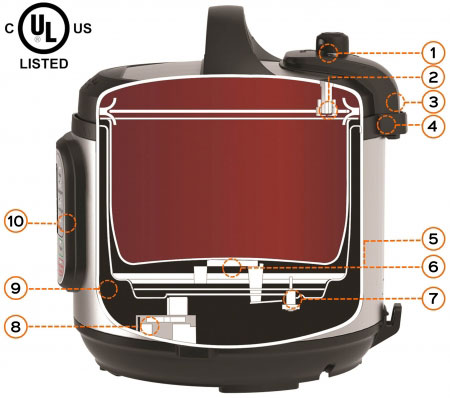Are Instant Pot Pressure Cookers Safe?
Is cooking with an Instant Pot safe?
Short answer: Yes!
Due to the extra safety measures that Instant Pot has built in, an Instant Pot is a lot safer than a traditional pressure cooker that you use on the stove. As long as you follow the instructions and take good care of your device, you can hardly go wrong.
You've probably heard them too, those horror stories from the past about pressure cookers exploding due to too high pressure. So isn't it strange that we wonder if the Instant Pot is really that safe? After all, it is a pressure cooker that works with the same high pressure.
Because we are enthusiastic users of these fantastic devices, we have had this question several times from people who were concerned about the safety of buying one. So to allay some of the fear of this, we'll discuss the security measures in detail here.
To start with, the basic safety systems, of which all Instant Pot devices have at least 10. We will also try to answer some frequently asked questions.
Minimum 10 Safety Mechanisms?
To be honest, the thought of at least 10 safety mechanisms put us at ease. Until we got the question why so many were needed. Maybe they expect something to go wrong and are they using this to cover themselves? This allowed us to take a closer look at the specific systems and what they do exactly. The manufacturer's website states that these measures are in place to prevent the most common mistakes. We are happy to explain more about what these mechanisms are and what they do exactly.

1. Steam release valve/Steam release valve
If you've ever used an Instant Pot, you'll know it has a steam exhaust system. This has been developed to release the pressure from the pan (by dissipating steam) before you can remove the lid from the pan.
The steam released from a pressure cooker is very hot and can cause severe burns or injuries, so this valve is crucial.
2. Anti-Block System/Anti-Block Shield
This is a metal cap that fits over the steam outlet pipe to prevent food residues from getting into it and blocking it. This allows the pressure to escape safely through the pipe.
3. Safety Lid Lock/Safety Lid Lock
To prevent pressure-related accidents, every Instant Pot is equipped with a system that locks the lid as soon as the pressure starts to build. This lock only opens when the pressure is completely out of the pan. Once the pressure is completely off the pan, the lid is easy to remove.
Warning: Never use force to open the lid! It is not safe to open a pan under pressure by forcing the lock.
4. Lid Position Detection/Lid Position Detection
If the lid is not seated properly or is not completely closed, the Instant Pot will not start the cooking program.
5. Automatic Temperature Control/Automatic Temperature Control
Every program has a safe temperature margin and this system ensures that the appliance stays within that margin.
6. Overheat Protection/Overheat (Burn) Protection
Overheating can occur when:
- After sautéing / sautéing is not (sufficiently) quenched, so that food is caked on the bottom of the pan
- The pressure cooker is used with too little liquid
- The inner pot is not making good contact with the heating element
- The inner pan has a problem with the heat distribution, for example because of starch that sticks to the bottom of the pan.
Upon recognizing a problem, the appliance will lower the temperature to prevent food burning until the situation that caused it is resolved.
The timer will stop and the display will show BURN.
Remove the plug from the socket, carefully remove the food from the pan and check that there are no abnormalities/damages and that everything is installed correctly.
7. Automatic Pressure Control/Automatic Pressure Control
A system designed to ensure that pressure remains controlled. As soon as the pressure becomes too high, the device will immediately stop heating, causing the pressure to drop.
8. Electric Fuse/Electrical Fuse
Disconnects the power supply if there is a problem with the voltage.
9. Thermal Fuse/Thermal Fuse
It switches off the power supply if the temperature safety limits are exceeded.
10. Leaky Lid Detection/Leaky Lid Detection
If steam leaks past the lid due to, for example, a damaged sealing ring; incorrect or not installing the silicone sealing ring or steam vent valve which is set to "Vent" instead of "Seal", the unit will not build up pressure. Steam leakage could cause food to burn. The unit monitors the preheat time and will lower the temperature if not enough pressure builds up within 40 minutes.
Safety Tips
Below are 10 additional tips that we have collected to keep in mind when using our Instant Pot:
1. Don't overfill the pan
The Instant Pot inner pot has a line that indicates where you can fill it, do not go over this. If the pan is overfilled, it is possible that the pressure is not established properly, or that food/moisture comes out of the valve.
For most dishes that you make under high pressure, this Max line at 2/3 is fine to stick to, but be careful when you cook things that expand. (see next point)
2. Watch what you put in it
It is important to remember that even a smart device has limits.
If there is not enough moisture in the pan, the pan cannot build up pressure, which can cause the food to burn. Therefore, make sure that you always put at least 1 cup (250ml) of liquid in the pan, such as stock, sauce or water.
Some ingredients expand during preparation. For example, for rice, grains and beans, do not fill the pan more than half, to give them space when they expand during cooking.
If you are cooking food that may splatter or foam such as apples, rhubarb, noodles and some grains (oatmeal!), pay extra attention. These can block the steam valve. We recommend that you take a good look at which recipe you use for this, within the community you can find commonly used recipes with large numbers of reviews.
3. Keep face and hands away from the escaping steam
The Instant Pot has a steam valve on top of the lid. When using Quick Release in recipes, a jet of steam comes out.
The steam will go straight up and although it makes a lot of noise it can't hurt as long as you don't get into this stream with your hands, put something over it or put your face over the valve.
4. Always inspect the lid
If the lid does not close properly, this can lead to risks. This is the reason that Instant Pot has an automatic lid lock, but this does not alter the fact that as a user you should always check the sealing ring before use. Make sure that it is clean and intact and that it fits well behind the rack. if you seeIf there are cracks in the ring or if it no longer fits tightly behind the rack, replace it immediately. If the lid is placed incorrectly, the screen will show Lid, in this case check the lid again and check whether it is correctly placed.
5. Use out of reach of children
Even with all the safety precautions, this is a device that works at high pressure, at high temperatures and with hot steam. Keep children away from the device.
6. An Instant Pot is not made for frying
Your Instant Pot can do a lot, including replacing a skillet. However, this does not mean that you can fry in this one. Do not fill an Instant Pot with oil for frying, this is not what it is made for. The Instant Pot Duo Crisp is partly an exception because of the airfryer function, but it is also not suitable for frying with oil!
7. Replace the silicone ring in time
The sealing ring is essential for the operation of the Instant Pot, because this closes the pan completely and the pressure can build up.
If it starts to crack, the pan can leak steam along the side of the lid, so always make sure that the ring is still in good condition and has no cracks. Since the ring is made of silicone, it can become hard or brittle over time, so we recommend replacing it every 2 years just to be safe.
8. Let the device do its job
The Instant Pot is a smart device, because of the automatic programs you no longer have to set timers or constantly check whether it is boiling or not sticking. If something is wrong, the device will let you know clearly with a message on the display and/or an audio signal, usually both.
So if you don't get any warning or error, you can just let the device do its thing. It can take a long time for the pressure to build up, and waiting for all the pressure to release seems even longer to us, but it's really important not to touch the valves while warming up, and especially not to force the lid before you know for sure that all the pressure is off.
9. Never open the lid until all the pressure has escaped
The lid of the Instant Pot and the contents of the pan are under pressure during cooking. If you were to try to remove the lid from the pan while still under pressure, the pressure would come out with force (similar to popping a balloon).
Therefore, never try to pull, pry or otherwise force the lid while the Instant Pot is under pressure.
10. Do not let the appliance cook under pressure unattended
One of the advantages of the Instant Pot is that you can cook your food at the touch of a button without having to worry about it. But when we start cooking under pressure, it is not wise to leave the house while the cooking program is still running, for example. Unexpected situations can be avoided if you're around to notice the Instant Pot's signals and take action if necessary (and unfortunately you may also need to scrape any caked-on food off the bottom if you forgot to add your liquids!) .
Is an Instant Pot Dangerous?
As long as you remain vigilant, use the device according to the safety instructions and regularly check the parts to see if there is anything wrong with them, then no, an Instant Pot is not dangerous.
To avoid unpleasant situations, it is important to check the device and its components before each use. Check, among other things, whether the silicone ring is in good condition, the outside of the inner pan is well dry, the rack that holds the ring in place must not be bent, check whether all valves are clean and move easily.
Can an Instant Pot explode?
It is important to know that all pressure cookers could theoretically explode due to the high pressure. Compared to a traditional pressure cooker, Instant Pot minimizes this risk thanks to all the safety precautions we mentioned above.
Is an Instant Pot Safer Than a Pressure Cooker?
Yes.
We are convinced that an Instant Pot is safer than a traditional pressure cooker! Parts could break, but Instant Pot's many security measures make it easy to identify and fix. If you follow the instructions for use and these basic safety rules, an Instant Pot is a wonderful device that you can enjoy for years to comecan have without fear!
But what about the stories about exploding pans?
According to fact-checking website Snopes where most of the sandwich stories, legends, rumours, and myths are explored, there is only one story related to Instant Pot, and this has nothing to do with explosions.
This 2018 story is about a different type of appliance (a slow cooker) from the same manufacturer, the now discontinued Gem 65 8-in-1 multicooker that could overheat. This appliance was not a pressure cooker. Instant Pot responded immediately and immediately recalled all these devices with certain batch codes that could have this problem.
Has there ever been a recall for Instant Pot due to explosion hazard?
The short answer to this? New.
Other than the Gem multicooker we mentioned above, there is no recall for the Instant Pot Duo pressure cookers.
The Instant Pot website provides information regarding a risk of shock recall of the Instant Pot Smart, this device is sold in the US and Canada only and only models purchased before June 1, 2015 and specifically stating that the other Instant Pot models from that time did not pose a risk.
During our search for information for this article, we were unable to find any reliable sources for exploded Instant Pot devices, when it comes to explosions, this has not once been an exploding device.
Would you like more of this kind of useful information? Sign up for our newsletter for the latest news, useful tips and advice, delicious recipes, and special offers. We email at most once a week.





